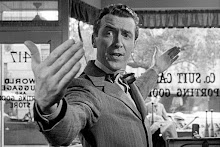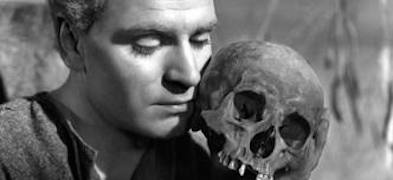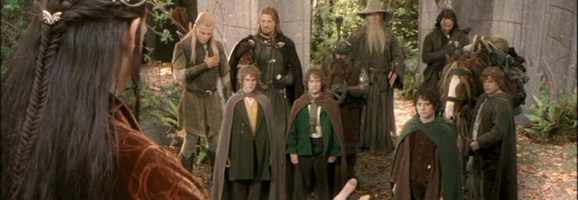Adaptation Distillation
It's a big issue, this whole relationship between novels and their film adaptations, so I think a good starting point would perhaps be with the most recurrent problem most people seem to have with adaptations, adaptation distillation. In layman terms, this is the cutting down of the source material--so to speak, 'distilling' certain aspects of plot and character through the filter of the film lens, screenwriters' hand and directorial choices, usually to make for a reasonable running time. Rarely is there an adaptation of any sort that does not 'distill' its source material, one way or the other. The main exceptions usually being short stories like A Christmas Carol, Brokeback Mountain, and some of Stephen King's adapted work. These require, instead, adaptation expansions, which are additions to the original text to lengthen the running time or add more plot elements (for example the inclusion of new characters into The Hobbit series to stretch one book into three films, any Dr. Seuss film, the excellent thriller Don't Look Now which changes a short but haunting Daphne Du Maurier story into a very in-depth character study of a grieving couple).
Full-length novels, however, would require an incredibly expansive miniseries - which is rarely an option - to fill in every single detail. Even a nearly four-hour long epic like Gone With the Wind required the cutting out of certain subplots and characters to manage it within even that hefty running time. It's not so much an issue of artistic licence as it is of pragmatism. Budgetary constraints aside, most people just wouldn't go out of their way to watch a film that pores over every single detail of its adapted source; this sort of limited scope would probably only appeal to the fandom of the novels. David Lean's two adaptations of Charles Dickens' Great Expectations and Oliver Twist are good examples of striking the balance between faithfulness and marketability of length and style. Elements of the original novel are changed—the latter even goes so far as to entirely remove the Rose Maylie subplot—but this doesn’t matter, it still successfully retain the atmospheric, barely controlled chaos of London presented by his prose and the characters perfectly embodied onscreen, particularly Alec Guiness who is unrecognizable as both Fagin and Herbert Pocket. Lean was a director who always had a firm, visionary outlook for all his films, and in his own class in imbuing his own style into films. I'll get more onto artistic licence in a bit, but Lean's Dickens adaptations, as well as some of his later, larger-scale work, most famously Bridge on the River Kwai, Dr Zhivago and of course, Lawrence of Arabia, show that there is a way to strike the balance between cutting down and adding on your own style and flair.
- Not only a masterful actor, Sir Laurence Olivier was also a talent at 'cutting' Shakespeare down into an audience-friendly medium of film, while retaining the original spirit.
Another good example of this are Laurence Olivier and Kenneth Branagh adaptations of Shakespeare's plays, which always make clear 'that it is an can only be, a pale version of the Shakespearean text' (Deborah Cartnell, The Shakespeare on Screen Industry, from 'Adapations: From Text to Screen, Screen to Text', 1999, Routledge: London and New York). They take various creative licenses--for example race-bending casting, increased British propaganda in Olivier's Henry V, stunt casting in Branagh's Hamlet--and cuts here and there to make it more appealing to the silver screen (although it should be noted that Branagh's version of the play is essentially the whole text in all its entirety onscreen), but still retain the Bard's original spirit through their faithful, respectful treatment of the source material.
Retrospective v.s. On-the-go Distillation
- Though their characterizations were modified slightly, the general dynamic of the Fellowship remained unchanged post-adaptation.
It's completely subjective whether it all 'works', so to speak, and I would never go so far as to say the trilogy is a completely faithful interpretation of the novels. The relative side-lining of Éomer's role, Tom Bombadil's excision, the removal of some of Gimli's more dramatic heft as a character to make him more of a comic relief character etc. differ from the novel significantly; but one thing Jackson and the scriptwriters did ensure was that even in places where the film and source material varied, they would all be means to a similar ends and conclusion. They took the recipe for a cake and modified it in bits and places, but always ensuring that nothing was missing, and that the final product would be realised in a similar fashion.
- Could've been a much more powerful moment had they stuck to the books.
It would've been very difficult for the filmmakers to, on the go, discern which and where to cut stuff; most of the time they stayed with playing it safe and focusing all characterization on the central trio, which worked to an extent, but also resulted in many of the more fan esoteric elements of the book being as developed as they could've been. Remus Lupin and Tonk's storyline might not have been as crucial to the plotline as say, the Deathly Hallows, but it would've been nice to have a bit more build-up to the emotional payoff their final scene with Harry requires of us.
The 'Skeleton' Adaptation
Another problem that faces adaptations, is when plot elements are so far removed from the source material that the originals seem to become mere skeletons of the original plot. Some critics argue that the act of transferring a character onscreen intrinsically simplifies him or her; and while that point must be held to a degree of contention, it is true that sometimes the act of going from page to screen must conform with certain 'changes necessary for dramatic effect in another medium, those required to conform to the producer's personal fantasies and his notions of what the public wants, and to meet the taboos of the Production code, and tailors it all to the screen personalities of the actors who will play the star roles' (H. Powdermaker, Hollywood the Dream Factory: An anthropologist looks at the movie makers,1951, London: Secker and Warburg, p. 153). A particular example of this would be the adaptations of the work of Raymond Chandler—or more specifically, Raymond Chandler’s Philip Marlowe, who has been portrayed onscreen multiple times in various adaptations, most notably in The Big Sleep (1946).
What John Paul Athansourelis calls the 'inherently cinematic quality of Chandler’s fiction' is ultimately upended by the conformities of the silver screen. The opening silhouettes of the two stars of the film, Bogart and Bacall, smoking during the opening credits of The Big Sleep clearly show that these two are to be the main attractions. The character of 'Silver Wig', a heartbreaking subversion of the typical blonde moll in noir fiction in the novel, is reduced to exactly that in the film adaptation; the final bleak twist of the novel is changed into a 'happy ending' with more resolution. One can argue in fact that Howard Hawks and the production team of The Big Sleep took the plot line from the novel and completely changed the tone from a gritty, downbeatin favour a lot of the deeper complexities of the novel and its darker, more sleazy elements are dropped not just due to the censorship of the times, but also due to the box-office necessity of any Bogart-Bacall coupling to be overflowing with innuendo and sexual tension, far removed from the terser and less savoury relationship between the two in the novel.
- Edward Norton's narration in 'Fight Club' strikes the perfect balance with the film's tone
Also, Philip Marlowe being the first-person narrator of Chandler’s fiction poses a significant problem for any adaptation as the detective genre is one in which the first-person narrator, if (s) he is present, must act as a channel between reader and writer. Often the best way to go about adaptating this is the more straightforward route of eschewing the narrative voice and leaving it to the visual to convey the scene; for example, 'I recall it being a dusky dawn evening and mama sitting on the porch knitting', instead of having narration over it, just simply filmed and told without a disembodied voice providing commentary. This sort of 'external' narration is much easier to adapt than the 'internal' narration some novels hinge almost entirely upon; 'The Big Sleep' without Marlowe’s voice runs into a hurdle from the outset as it removes so much of the strong sense of vantage the novel provides with his sardonic yet meticulous narrative voice.
Graham Greene's 'The End of the Affair' is another notable example of the difficulty of adapting the narrative voice. It has twice been adapted to film, and the medium does kind of hurt the source material a bit. Every moment that strays from Maurice Bendrix's narrative voice, which writes 'against the bias because it is my professional pride to prefer the near-truth, even to the expression of my near-hate', kind of reduces the impact of the book's conflict between feigned objectivity and Bendrix's passions, as well as eschewing a whole lot of the whole metanarrative flair to Greene's story. The plot of The End of the Affair itself is strong enough to make a good enough skeleton for your typical melodramatic romance, but the near-impossibility of conveying Bendrix's narrative voice alongside it means that a lot of the novel's original power is lost.
There are ways in which narrative voiceover can work onscreen, whether it be in small portions at crucial moments (i.e. To Kill a Mockingbird) or as an extensive framing device (The Shawshank Redemption, Fight Club), but it is definitely a challenge; these successful adaptations have to not only employ is as an expositionary device, but also make it contingent with the fictional universe they are writing in. The narration in TKAM works so well because it feels so of its time; Morgan Freeman's voice simply just feels right reading Stephen King's words even if he's cast very differently to the Red envisaged in the books; Edward Norton's narration as the unnamed narrator in Fight Club is knowingly snarky, and fits right in with the tone David Fincher sets with the film.
- Brody and his companions' plights are all the more soundly felt via adaptation.
Conclusion?
So is straying from the source material always a bad thing? Not necessarily. Sometimes taking the skeleton story and employing artistic license with the text, can bring about a masterpiece. Stanley Kubrick took a very serious, understated political thriller novel called Red Alert and turned it into the classic dark satire Dr Strangelove; Stephen Spielberg basically took just the idea of a giant killer shark from Jaws and turned it from a pulpy piece of horror fiction into a magnificent masterclass in suspense and characterization. David Lean, knowing that he could not possibly encompass all the elements of the epic Dr Zhivago into his adaptation, chose to make it mostly just one magnificent epic love story, and an incredibly compelling one at that; Milos Forman provoked the ire of Ken Kesey when he adapted the latter's One Flew Over the Cuckoo's Nest, because he had not kept in Chief Bromden's narrative POV, but Forman did his best to maintain the novel's representation of Jack Nicholson's Randle McMurphy as a sort of Christ figure to the asylum inmates, 'big as a damn mountain' through Nicholson's wonderfully grand performance, while still grounding it with the more objective film lens the flaws of the character.
Books and films, as two different forms of media, do (and rightly so) have different rules and expectations. The adaptation fidelity of a film to its original text should not be what it is measured against; rather the quality of the film should be judged in itself, before factoring its source material.






No comments:
Post a Comment